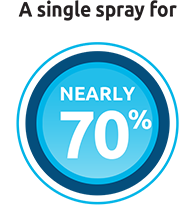A SINGLE SPRAY MAY BE ALL THE MAJORITY OF ADULTS NEED1

Nearly 70% of migraine attacks in adults treated with ZOMIG Nasal Spray 5 mg* DID NOT require additional medications within 24 hours vs 27.8% with placebo†1
- 67.7% with ZOMIG Nasal Spray 5 mg
- 60.7% with ZOMIG Nasal Spray 2.5 mg
Pain free‡ is possible for some adult patients2
Nearly 36% of adult patients using ZOMIG Nasal Spray 5 mg were pain free at 2 hours vs 6.4% with placebo
- 35.5% with ZOMIG Nasal Spray 5 mg
- 21.0% with ZOMIG Nasal Spray 2.5 mg
*The recommended starting dose of ZOMIG Nasal Spray is 2.5 mg.3
†Includes both patients who had a headache response at 2 hours and those who had no response to the initial dose. The trial protocol did not allow remedication within 4 hours postdose. P≤.0001 for all comparisons with placebo.1
‡Pain free was defined as a reduction in headache severity from severe or moderate pain to no pain (P=.0001 vs placebo).2
From a multicenter, randomized, double-blind, double-dummy, placebo-controlled study of ZOMIG Nasal Spray 5 mg (n=235) and 2.5 mg (n=224) vs placebo (n=226) for the acute treatment of moderate or severe migraines in adults. Primary endpoint was headache response at 2 hours. Secondary endpoints included the use of rescue medication and pain-free outcomes.1,2

ZOMIG Nasal Spray is a serotonin (5-HT)1B/1D receptor agonist (triptan) indicated for the acute treatment of migraine with or without aura in adults and pediatric patients 12 years and older.
Limitations of Use:
Use ZOMIG Nasal Spray only after a clear diagnosis of migraine has been established. If a patient has no response to ZOMIG Nasal Spray treatment for the first migraine attack, reconsider the diagnosis of migraine before ZOMIG Nasal Spray is administered to treat any subsequent attacks. ZOMIG Nasal Spray is not indicated for the prevention of migraine attacks. Safety and effectiveness of ZOMIG Nasal Spray have not been established for cluster headache. ZOMIG Nasal Spray is not recommended in patients with moderate to severe hepatic impairment.
Important Safety Information
Contraindications:
- History of coronary artery disease (CAD) or coronary artery vasospasm or other significant underlying cardiovascular disease
- Wolff-Parkinson-White Syndrome or arrhythmias associated with other cardiac accessory conduction pathway disorders
- History of stroke, transient ischemic attack, or hemiplegic or basilar migraine
- Peripheral vascular disease
- Ischemic bowel disease
- Uncontrolled hypertension
- Recent (within 24 hours) use of another 5-HT1 agonist (eg, another triptan), or ergot-type medication
- Current or recent (past 2 weeks) use of monoamine oxidase (MAO)-A inhibitor
- Known hypersensitivity to ZOMIG, ZOMIG-ZMT, or ZOMIG Nasal Spray
Warnings and Precautions:
- Myocardial ischemia, myocardial infarction, and Prinzmetal’s Angina: Perform a cardiovascular evaluation in triptan-naïve patients who have multiple cardiovascular risk factors and if satisfactory, consider administrating the first ZOMIG Nasal Spray dose in a medically supervised setting
- Arrhythmias: Discontinue ZOMIG Nasal Spray if these occur
- Sensations of tightness, pain, pressure in the chest, and heaviness in the precordium, throat, neck, and jaw commonly occur after treatment with 5-HT1 agonists like ZOMIG Nasal Spray and are usually non-cardiac in origin. Perform a cardiac evaluation if these patients are at cardiac risk
- Cerebrovascular events: Cerebral hemorrhage, subarachnoid hemorrhage, and stroke have occurred in patients treated with 5-HT1 agonists, some resulting in fatalities. Discontinue ZOMIG Nasal Spray if any of these events occur
- ZOMIG Nasal Spray may cause non-coronary vasospastic reactions, such as peripheral vascular ischemia, gastrointestinal vascular ischemia and infarction, splenic infarction, and Raynaud’s syndrome. Discontinue ZOMIG Nasal Spray if any of these events occur
- Transient and permanent blindness and significant partial vision loss have been reported with the use of 5-HT1 agonists
- Overuse of acute migraine drugs may lead to exacerbation of headache. Detoxification may be necessary
- Serotonin syndrome may occur with triptans, including ZOMIG Nasal Spray, particularly during co-administration with selective serotonin reuptake inhibitors (SSRIs), serotonin norepinephrine reuptake inhibitors (SNRIs), tricyclic antidepressants, and MAO inhibitors. Discontinue ZOMIG Nasal Spray if serotonin syndrome is suspected
- Increase in blood pressure
Adverse Reactions
- Adults: unusual taste, paresthesia, dizziness, and hyperesthesia
- Pediatrics: unusual taste
Drug Interactions
- Cimetidine: If co-administered, limit the maximum single dose of ZOMIG Nasal Spray to 2.5 mg, not to exceed 5 mg in any 24-hour period
Use in Specific Populations
- Pregnancy: Based on animal data, ZOMIG Nasal Spray may cause fetal harm
- Lactation: There are no data on the presence of zolmitriptan or its metabolites in human milk, effects on milk production, or on the breastfed infant
- Pediatrics: Safety and effectiveness of ZOMIG Nasal Spray in patients <12 years of age have not been established
To report SUSPECTED ADVERSE REACTIONS, contact Amneal Specialty, a division of Amneal Pharmaceuticals LLC at 1-877-835-5472 or FDA at 1-800-FDA-1088 or www.fda.gov/medwatch.
